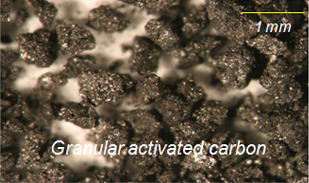BACKGROUND
Activated (AC) carbon filtration is a well-established treatment practice for removing organic contaminants from water. Produced from coal or biomass feedstock and treated at high temperature to produce a highly porous structure with great sorption capacity, AC filtration of water is a part of our everyday lives. AC filters are used to purify municipal drinking water, pre-discharge polishing at sewage treatment plants, cleaning recycled water at golf courses, filtering waste build up in aquariums and home fish tanks, and at our homes with in-line or counter-top filtration systems. AC is also used in air filtration systems and as a treatment for humans who have consumed certain poisons. AC filtration is especially effective at removing at hydrophobic-organic contaminants (HOCs). HOCs include pesticides (e.g., DDT, atrazine), polycyclic aromatic hydrocarbons (PAHs), polychlorinated biphenyls PCBs), dioxins, and phthalates.
|
|

- Activated (AC) carbon filtration is a well-established treatment practice for removing organic contaminants from water.
- AC is highly effective at sequestering hydrophobic organic contaminants (HOCs) such as pesticides, polycyclic aromatic hydrocarbons (PAHs), and polychlorinated biphenyls (PCBs)
|



